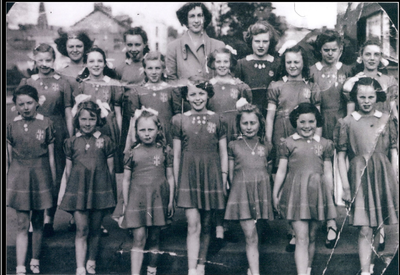|
Agnes McConnell (Close), was born in 1901 at 1 Railway Street, Ballymena. It isn't clear who taught Agnes McConnell to dance in the Irish style promoted by the Gaelic League, but Ballymena was a hub of traditional dancing in Agnes’ formative years, and the Protestant Hall in the 1910s and 1920s regularly accommodated Irish night festivities. Agnes ran what the family called the “original and only dancing club in Ulster” in Railway Street from at least the late 1920s, if not earlier. Most of the McConnell siblings were involved in dancing, including Sam (b.1911), Fred (b.1915) and Pearl (b.1920). The children grew up in Harryville, a working class area of town that provided manpower for the local linen mill. Most of Agnes McConnell’s aunts and uncles worked at the mill — her mother, Margaret was a spinner and her father, David, a fitter. The McConnell family, who belonged to the Church of Ireland, would not have been part of the Gaelic League’s new dawn of saffron and green. Those Protestants involved in the Gaelic League revival of the early 1900s tended to be from middle class or aristocratic stock. Harryville was a unionist, working class and Protestant heartland where the voices were ‘broad Scotch’ and a Twelfth of July arch was decked out in in red, white and blue. The McConnells appear at the 1929 Ballymena festival as ‘The Shamrock team,’ featuring Miss Pearl McConnell, younger sister of Agnes. Their performance was noted by adjudicator, Mr Denis Cuffe, as the finest he’d seen in a life-time. In subsequent years, the McConnell dancers were entered into competitions under the name of ‘Miss McConnell’s school.’ Sally McCarley, who later taught her cousin, Sadie Bell (née Kernohan), was instructed by Agnes McConnell in the early 1930s. Sadie, who set up the Seven Towers School of Irish dancing in 1950, also  Jean Tennant (left). Agnes McConnell (Right) with McConnell Trophy, Ballymena (Source: http://www.mcconnelldancers.com) Jean Tennant (left). Agnes McConnell (Right) with McConnell Trophy, Ballymena (Source: http://www.mcconnelldancers.com) performed with Patricia Mulholland, but she remained friends with the McConnells (and later travelled to Canada to help the McConnells teach the latest techniques in Irish dancing to their pupils). The McConnell school of dancing catered for both Irish and ballroom in the 1940s with Sam McConnell at the helm of ballroom, and the school won many medals at dancing festivals during that time. In a 1946 advertisement, the school boasted 22 first prizes at the Ballymena and Portstewart festivals for Irish dancing. Future teachers, Lily Agnew and Jean Tennant (née Graham) were taught by Sam McConnell in the 1940s. Sam’s adopted sister, Nan McConnell, won the senior championships of the Irish folk dancing in Portstewart in 1946. She also performed with Lily Agnew in displays and concerts. The factories continued to serve as a backdrop to the dancing scene when the Braid Water Recreation club opened in 1946. The team met at the Mill canteen and competed at the first Festival of Britain during the summer months of 1951. The Braid Water Irish dancing team competed across Northern Ireland and England under the tuition of Agnes. The Winnipeg connection Sam McConnell followed in his brother’s footsteps and emigrated to Canada in 1947. Travelling with him were his wife, Sarah, who he had met at a ballroom dancing competition, and his three children. His sister, Nan, also followed her siblings to Canada. Despite the relative peace of post-war Northern Ireland, many people travelled across the Atlantic to seek work as the linen trade went into decline, and whilst the USA had a strong Irish Catholic diaspora, Canada proved to be a natural home for emigrants from Ulster in the 1940s and 1950s. Sam McConnell worked at Eaton’s department store in Winnipeg, Manitoba, but continued the family dance tradition in his spare time. He became involved in show business, choreographing CBC shows and local productions. He also founded the Folk Arts Council for Winnipeg, for which he and his wife both received citizenship. Sam’s dancing genes were passed onto his daughter, Pearl McConnell, and granddaughter, Shayleen McConnell Finucan. Shayleen now runs the Winnipeg-based McConnell School of Dance, a member of the feis Irish dancing governing body, Cumann Rince Náisiúnta (CRN). Sam’s brother, Fred, who stayed in Northern Ireland and moved to Larne, was also a successful Irish dancer in his youth and ran ballroom dance classes in Larne, Ballyclare, Ballymena and Antrim in the 1950s. Fred’s son also Irish danced and his great granddaughters continue to dance today. The McConnell Irish dancing line may well be one of the longest in Northern Ireland and the McConnell family can be credited with spreading Irish dancing to working class children and adults in Ballymena, Ballycastle, Coleraine and beyond. Agnes McConnell was a pioneer of the festival tradition of Irish dancing and the fact that Irish folk dancing is so widespread in Protestant communities in County Antrim today, is a direct result of the work of the McConnell family. Angeline King is the author of: Irish Dancing: The festival story A history of dancing in Ulster with a focus on the festival tradition of Irish Dancing. Snugville Street "An enjoyable coming-of-age tale with a Belfast twist" (The Irish Times) Click here to start reading. A Belfast Tale: “Uniquely, authentically and enjoyably Belfast" (Tony Macaulay, author of Paperboy.) Click here to start reading Children of Latharna: Lyrical and nostalgic; wistful and humorous, Ian Andrew, author. Click here to read for free Soldier's Joy was a well known tune and country dance at the time of the revival of Irish dancing. The McConnells handed this dance down to teachers like Sadie Bell and Jean Tennant.
1 Comment
|
ProseHistory & folkloreJean Park of Ballygally
Fiddles and Melodeons Martha Taylor's diary Jean McCullagh at 104 Ballymena & the McConnells Arms in Irish Dancing Catholics & Protestants in Irish dancing Dancing in Victorian Ulster Essays
|



 RSS Feed
RSS Feed